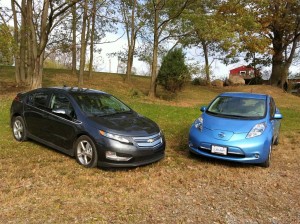This story has been revised to show production and sales forecasts for the Volt and Opel Ampera.
Roughly eight months in from its much-ballyhooed launch, analysts are debating whether the Chevrolet Volt plug-in hybrid is a success or failure. The answer likely depends on how you count the numbers.
The figures certainly weren’t good for July, Chevy selling just 125 of the compact battery cars. For the year-to-date, that means sales have fallen just short of 3,200. By comparison, Nissan has so far sold almost 4,500 copies of its Leaf battery-electric vehicle, which launched about the same time as Volt.
Either of those figures, it should be noted, are barely equal to the number of F-Series pickups produced at a single plant in a typical week. But both Nissan and Chevrolet have warned that demand will take time to build for the new technology. And both makers sharply constrained production in the early months after launch.
A key reason was to ensure quality control on products that require dramatically different manufacturing strategies than conventional automobiles. Even so, Nissan had to correct a defect with some early Leafs. The Japanese maker’s roll-out schedule was also impacted by the March 11 Japanese earthquake and tsunami which curtailed production for all that nation’s automakers.
But over the last two months, Nissan has been rapidly ramping up Leaf production and the sales numbers are starting to reflect that increased availability. The maker ultimately expects to deliver about 10,000 of the battery cars to American customers by year’s end. In late 2012 it will begin production of the Leaf at its assembly plant in Smyrna, Tennessee, which will have a capacity to roll out as many as 150,000 battery cars annually.
Complicating the Chevy Volt roll-out, General Motors took its plant down for an extended model changeover last month, meaning that dealers had to wait for new deliveries. A report in the Detroit Free Press notes that there are barely 100 of the battery cars available on dealer lots.
Production before the shutdown had reached a meager 4,488 Volts. But as the factory comes back online, assembly rates will rapidly increase, and Mark Reuss, who heads GM’s North American operations, says the goal is to sell a total of 10,000 of the plug-ins by year’s end — or 6,800 more than it actually sold through the end of July. With less than five months left in 2011, that would require a significant jump in demand, as well as production.
GM would need to deliver, on average, nearly 3,000 Volts a month through the end of the year.
But its ambitions are even greater – with a target of 60,000 in 2012 — 45,000 of which are earmarked for the U.S. CEO Dan Akerson has been pushing even harder, and when you combine Volt sales with those of the European Opel Ampera plug-in, the maker would like to nudge 100,000 annually.
So, a company insider insisted, the numbers to date tell relatively little of the story. The real test will come in the final quarter of 2011 as production ramps up. Then we’ll see if the Volt really charges up the market or simply short-circuits.


If you would like to at success v. failure so far, that answer is easy: It was a success.
It is clear that demand is larger than supply. There are no Volts being sold at a discount right now. There is a 4 month wait to get one.
So far the vehicles has been available in 6 of 50 states (and no other countries).
I would liken sales evaluation so far to be equivalent to judging the success of a Harry Potter Movie based on the attendance of the world premiere in London.
More: http://bobbleheadguru.com
Good points all, Guru, and I agree with you. As the story suggests, it simply is too early to get a true measure of demand for either Volt or Leaf. Were the two piling up that would be one thing, but even if production numbers were already high, sales were sting and the two products were available in all 50 states, all we would be able to say for sure is that demand among early adopters was strong. The test will come in the months after production hits stride and availability goes nationwide, as those initial buyers are satisfied and the makers start to pitch to the mainstream.
Paul A. Eisenstein
Publisher, TheDetroitBureau.com